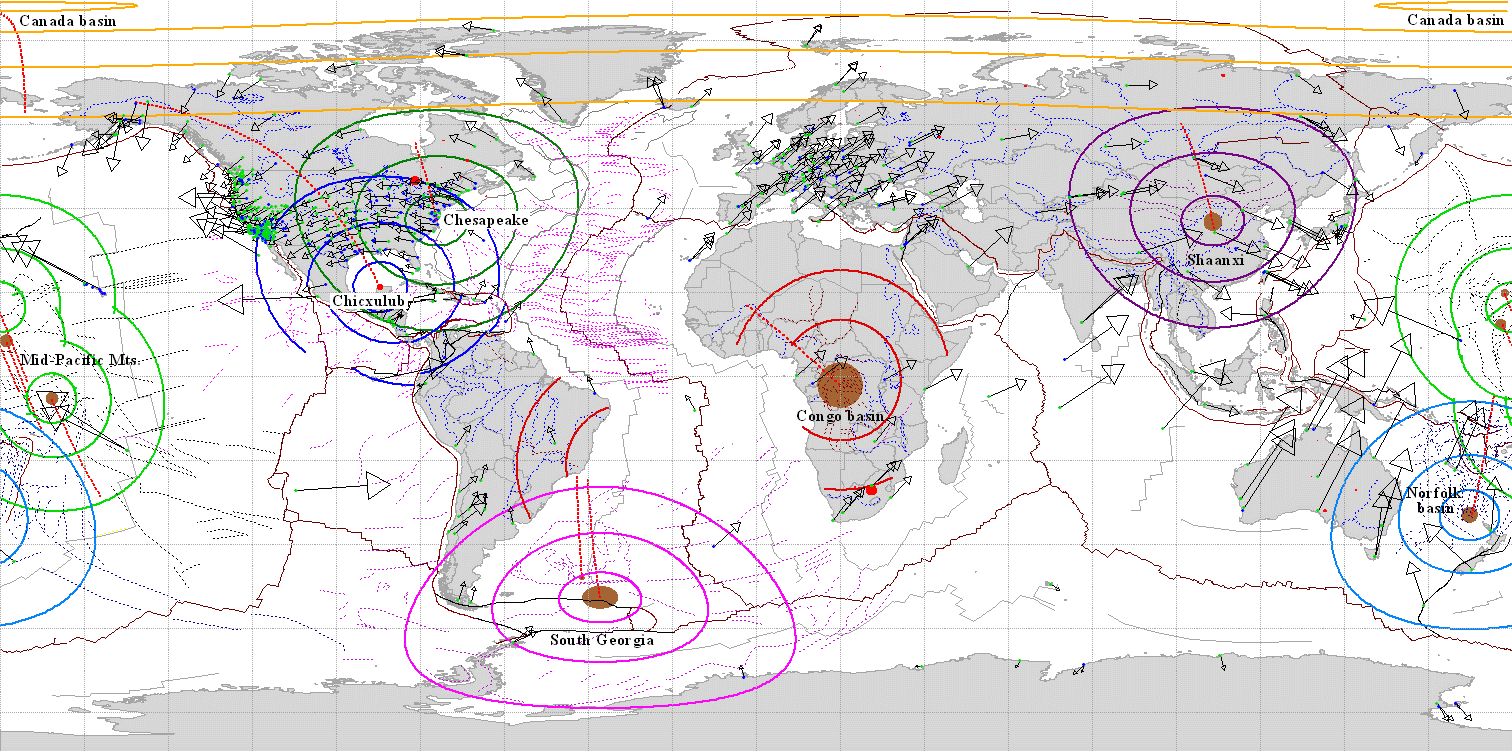2010 Far-Field Bolide-Impact Strains on Earth
Gregory Charles Herman,
PhD
Flemington, New Hersey, USA
Introduction
Crustal strains and plate motions with respect
to 2 known and 6 suspected impact events
Crustal fractures,
welts, wedges and ovelapping strain fields from oblique
impacts
The End Cretaceous
Chicxulub event
The Late Eocene
Chespapeake Invader; wedge drift from post-impact plate
rotation
Suspected Paleozoic Shaanxi
impact, central China
Suspected End
Permian impact in the Congo Basin, Africa
Suspected Early Cretacous
Mid-Pacific Mts impact complex; precursor of the Cretaceous long normal
event?
Suspected Miocene-age
impacts in the South Georgia rise and the Argentine abyssal plain, southwest
Atlantic Ocean
Suspected
Eocene-age impact in the Norfolk basin, West Pacific
Suspected Tertiary age impacts in the Canada basin, Arctic Ocean
Discussion
References
Introduction
Far-field crustal strains on Earth are mapped below with respect to known
and suspected bolide-impact carters. Maps for each impact site are generated
using geographic information systems (GIS) and computer-aided drafting
(CAD) software with spatial coordinates registered in both geographic
and spherical space. The spherical system uses a Lambert equal-area projection
centered on the impact for a single impact, or about the approximate
center of an impact complex for more complex ,multiple -impact events. The
physical relationships of the known impacts have helped constrain aspects
of the suspected ones. These impact events on Earth are thought to influence,
and perhaps help drive plate tectonic motions. This work is in progress,
and is an evolving record of my observations and thoughts on the structural
and geodynamic processes stemming from large, hypervelocity, bolide impacts
on terrestrial planets. As such, it represents a departure from current plate
tectonic theory for Earth, that relies on other causal mechanisms for driving
tectonic plate motions. I'm assembling these ideas using the world-wide-web
in an effort to communicate the hypothesis and to advance our understanding
of Earth's geodynamic processes, many of which remain sketchy. The basic
hypothesis is that far-field crustal strains stemming from large impact
events are a substantial component of a more comprehensive plate-tectonic
theory that includes large-scale tectonic strains, and long lasting geodynamic
processes stemming from very-high-energy bolide impacts on terrestrial planets.
I hope you will recognize these strain effects as more that just
cooincidental trends, and entertain the idea that large bolide impacts spur
deep-seated processes that are not yet fully understood aspects of plate-tectonic
theory.
Crustal strains and plate motions with respect
to 2 known and 6 suspected impact events
Far-field strains on Earth from 2 known (Chicxulub and Chesapeake) and 6
suspected impact sites (Canada basin, Congo basin, Mid-Pacific Mountains,
Norfolk basin, Shaanxi, South Georgia) are shown below.
Splash rings are shown using colored
line traces at 660, 1550 and 2900 km radius around each impact. The rings
trace circumferential regions of uplift and subsidence around each site.
Black vectors show current, horizontal azimuth and magnitude of tectonic-plate
motions based on NASA
JPL GPS data. Vector lengths are variably-scaled with the horizontal
velocity for each GPS station multiplied by 0.25 geographic degrees. The
average horizontal velocity for the crustal plates is about 27 mm/yr based
on time-series data for 778 GPS stations. Station points are color coded
blue for stations having negative vertical motion (subsidence) and green
for positive (uplift), respectively. Red-dashed lines originate at impact
craters and extend foreland of each crater in the direction of crustal
compression; in line with interpreted paths of oblique descent for the different
projectiles. The thin-dashed, colored lines trace surface features
including ocean-floor transform faults and other continental lineaments that
highlight crustal fractures and faults that either stem from far-field strains
associated with the different impact events, or are perturbed by them.
Tectonic-plate boundaries are shown as thick maroon and black lines. The
thin gray lines on the sea floor trace the M34 magnetic isochron.
Click on the image for more resolution. Click
here for a Google Earth KMZ
file of this map..

Plate motions in the southern hemisphere currently diverge northward away
from the suspected impacts near
South Georgia in
the southwest Atlantic Ocean. Plate motions also move in line and away from
suspected impacts in the
Norfolk basin in
the southwest Pacific Ocean and the
Canada basin in the
Arctic Ocean. However, plate motions associated with the
Chicxulub impact and
a suspected (Middle Paleozoic?) impact in the
Shaanxi province of China
are pivoting around these impact sites, suggesting that large impacts can
temporarily pin the crust to the mantle. Taken together, these relationships
show that large impact events produce long-lasting geodynamic responses,
probably operating to dissipate energy fluxes imparted by large-impact
events. Moreover, most of these impacts show nearby fragmentation of
tectonic plates, especially in hinterland regimes of crustal extension.
Large-bolide impacts therefore appear to drastically influence Earth geodynamics
to a degree that we are only beginning to realize.
The South Georgia event may have occurred in the Middle Miocene during the
Langhian (13.65–15.97 mya) stage when there was a sudden
warming
trend in Antarctica (~15.7 mya ), changes in Atlantic and Pacific
ocean
circulation, and subsequent
extinction
waves of terrestrial and aquatic life forms (~14.8 to 14.5 mya).
The distribution of tektites
in the North American tektite strewn field also shows a remarkable spatial
coincidence with the proposed foreland trajectory of the South Georgia impacts
even though it is currently thought to stem from the Chesapeake impact of
Eocene age (~35 Ma).
To be continued.....
 www.impacttectonics.org
www.impacttectonics.org